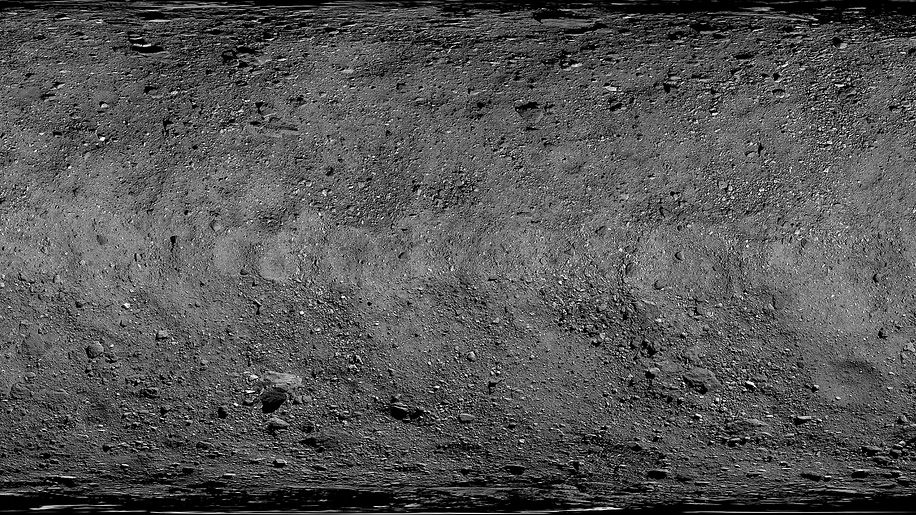'Hopping' space dust may help asteroids bust a move
Popcorn-like surface bursts may assist with space rock migrations.

Snap, crackle, pop! Dust 'hopping' on asteroids might influence how these small bodies migrate through space.
Fresh imagery from asteroids Bennu and Ryugu helped inform the new findings, which might explain the pathways these space rocks take as they orbit the sun and occasionally, stray near Earth.
"The more fine-grained material, or regolith, these asteroids lose, the faster they migrate," lead author Hsiang-Wen (Sean) Hsu, research scientist at the Laboratory for Atmospheric and Space Physics at the University of Colorado, Boulder, said in a statement.
Some "curious" photos captured at Bennu, as the scientists termed it, sparked the discussion. These came courtesy of an asteroid-sampling mission known as OSIRIS-REx and showed that the surface was sandpaper-like, defying scientists expectations of smoothness. Similar images flowed from another recently studied asteroid called Ryugu, explored by a Japanese spacecraft known as Hayabusa2.
Related: Dramatic sampling shows asteroid Bennu is nothing like scientists expected
Hsu and co-lead author Xu Wang, a research associate at LASP, helmed a team creating computer simulations and laboratory experiments to better explain the imagery from these two worlds.
"Forces akin to static electricity may be kicking the smallest grains of dust, some no bigger than a single bacterium, off the asteroid and into space — leaving only larger rocks behind," the statement said. The same process may even be at play in places like the rings of Saturn, another spot filled with airless, tiny worlds.
Get the Space.com Newsletter
Breaking space news, the latest updates on rocket launches, skywatching events and more!
Asteroids are constantly spinning worlds and because they are so small, sunlight falling on their surface varies considerably. One small region may flash quickly between sunlight and shadow and strain surface rocks until they crack.
Even dust grains are affected, as they are thrown into space through a process called electrostatic lofting. The sun's light upon regolith eventually builds up negative charges on individual dust particles.

When the charge accumulates enough, the particles pop away from each other like two repelling magnets, at speeds sometimes exceeding 20 mph (30 kph).
"No one had ever considered this process on the surface of an asteroid before," said Wang.
Simulations appear to show the most effect from explosions of dust on smaller asteroids, because these tiny worlds have comparatively weaker gravity. On the smaller worlds, similar in size to Ryugu, regolith may be lost into space over the eons.
This loss not only creates the boulder-strewn landscape visible on Bennu and Ryugu, but given enough time an asteroid could lose much its dust. A "cleaner" surface is more exposed to the effects of the sun's radiation, which can push the orbit in a different direction given enough time.
While the effects are still poorly understood, scientists hope to gain more information with NASA's forthcoming Double Asteroid Redirection Test (DART) that will visit two other asteroids of similar scale to Ryugu and Bennu. DART will arrive at the system, called Didymos, in September and slam into the smaller rock to conduct an asteroid impact test.
A story based on the research was published July 11 in Nature Astronomy.
Follow Elizabeth Howell on Twitter @howellspace. Follow us on Twitter @Spacedotcom and on Facebook.
Join our Space Forums to keep talking space on the latest missions, night sky and more! And if you have a news tip, correction or comment, let us know at: community@space.com.

Elizabeth Howell (she/her), Ph.D., was a staff writer in the spaceflight channel between 2022 and 2024 specializing in Canadian space news. She was contributing writer for Space.com for 10 years from 2012 to 2024. Elizabeth's reporting includes multiple exclusives with the White House, leading world coverage about a lost-and-found space tomato on the International Space Station, witnessing five human spaceflight launches on two continents, flying parabolic, working inside a spacesuit, and participating in a simulated Mars mission. Her latest book, "Why Am I Taller?" (ECW Press, 2022) is co-written with astronaut Dave Williams.









